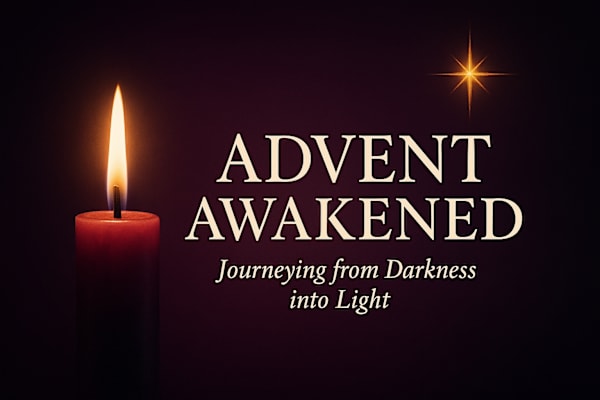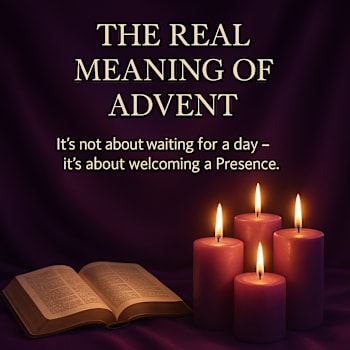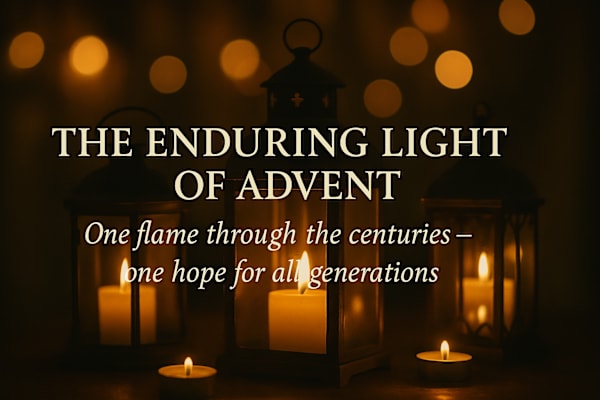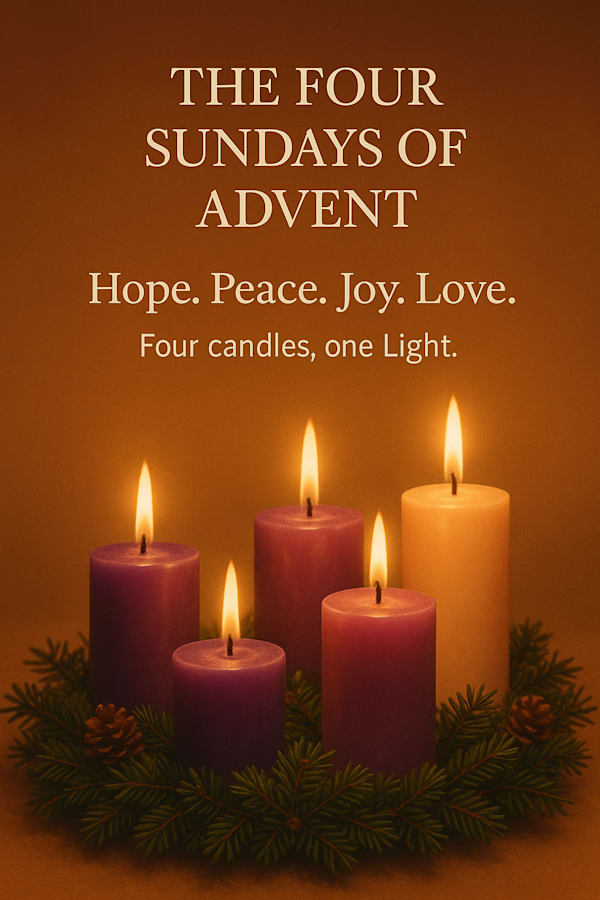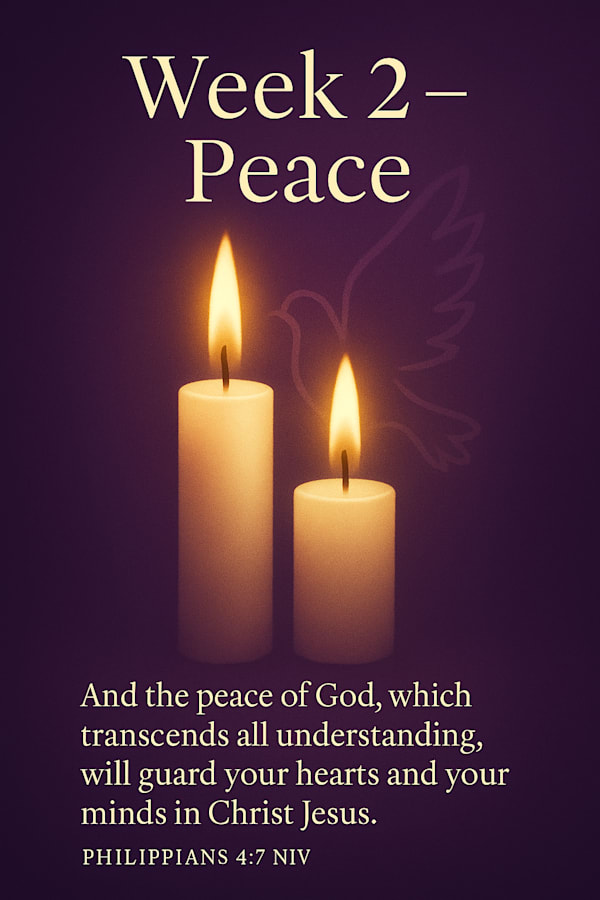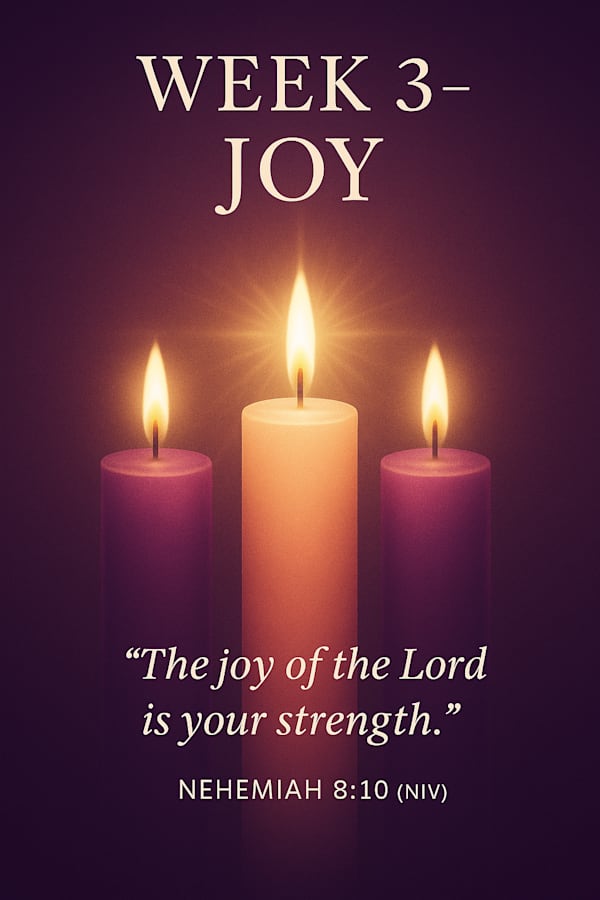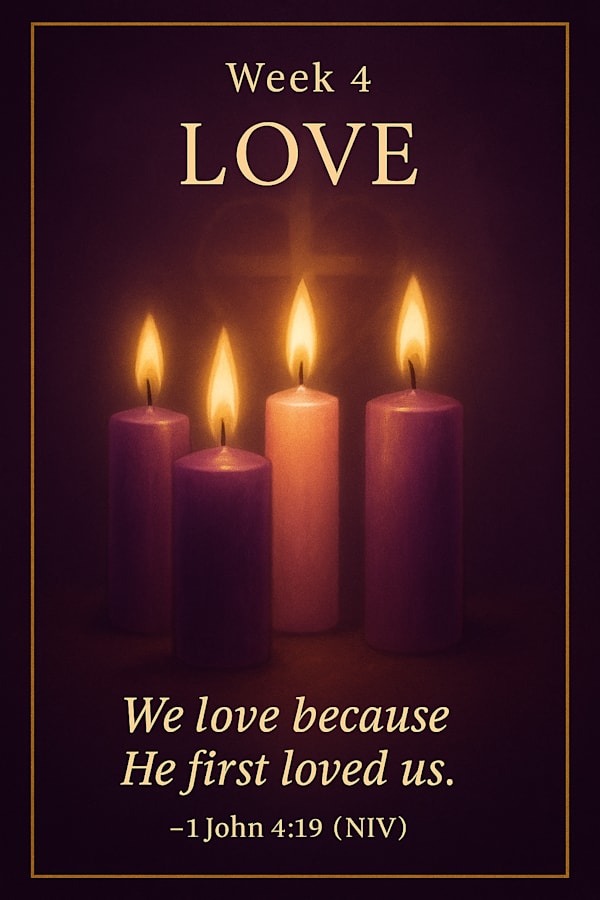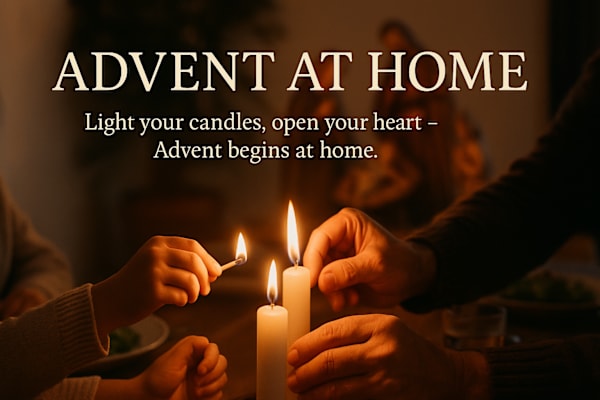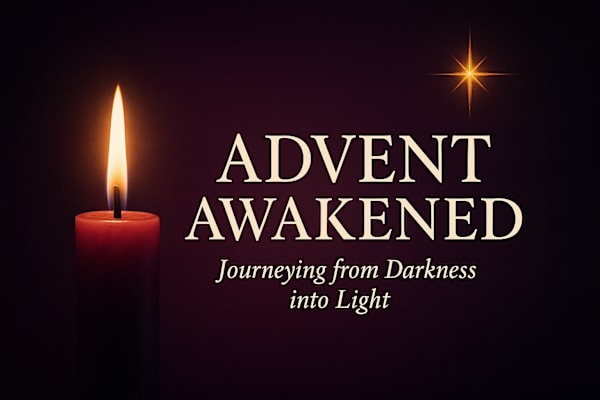Advent Awakened – Journeying from Darkness into Light Page
Advent Awakened – Journeying from Darkness into Light Page
(by Mark Edward Chard)
Introduction – Why Advent Still Matters
Welcome, dear friends in Christ,
As we approach Christmas, our hearts are often pulled in many directions, shopping lists, decorations, and celebrations. Yet amid all the noise, Advent quietly calls us back to what truly matters: preparing room for Jesus Christ in our hearts.
Advent is the Church’s season of waiting, not passive waiting, but hopeful anticipation. It’s a sacred time of spiritual renewal, reflection, and joy. Each candle we light tells a part of God’s story, the story of hope, peace, joy, and love breaking into the darkness of our world.
The first followers of Christ used this season to fast, pray, and prepare for the coming of the Messiah. Today, Advent invites us to do the same, but with the added joy of knowing that the Light has already come, and that same Light continues to shine through us.
Advent is a journey. It begins in stillness and ends in celebration, a pilgrimage of the heart that mirrors Mary and Joseph’s road to Bethlehem. It reminds us that even in the waiting, God is at work, shaping us, preparing us, and calling us closer to Him.
So whether you’re lighting candles, reading Scripture, or simply pausing to breathe and pray, may this Advent season awaken something deep within you, a renewed wonder for the miracle of Christ’s birth and the promise of His return.
Together, let’s rediscover the joy of expectant waiting and allow Christ’s light to guide us once more from darkness into light.
Come, Lord Jesus. Be born in us again.
— Mark Edward Chard
The Original Origins of Advent – Where the Journey Began
Advent’s story begins long before calendars and candles, in the humble beginnings of early Christianity.
Around the 4th and 5th centuries, as believers deepened their faith, a special season emerged: a time of spiritual preparation and penance, much like Lent, created to help Christians ready their hearts for the birth of Christ.
The first evidence of Advent appears in Ravenna, Italy, where monastic communities dedicated days of fasting and prayer in anticipation of Christmas. In some regions, such as Gaul (modern-day France), Advent lasted up to six weeks, a far longer period of devotion than the four weeks we know today.
Those early Christians saw Advent not as a celebration, but as transformation. Through fasting and repentance, they waited not only for the Nativity, but for the Messiah’s light to pierce the world’s darkness.
It’s no coincidence that Advent coincides with the darkest days of the year, for it symbolizes the triumph of divine light over human shadow. And just as the winter solstice gives way to longer days, Advent reminds us that the dawn of salvation has already begun in Christ.
“The people walking in darkness have seen a great light.” — Isaiah 9:2 (NIV)
Author’s Note – What Advent Means to Me
Advent, to me, is far more than a season on the calendar, it’s a sacred rhythm that reminds my heart who I belong to.
Each year, as the nights grow longer and the air carries that quiet chill of December, I feel the same invitation from God: slow down, listen, and prepare your heart for something extraordinary.
Advent is that holy space between promise and fulfillment, between the Word spoken and the Word made flesh. It’s where faith stretches, hope deepens, and love takes root once again.
In our world of instant everything, Advent teaches me the beauty of waiting well. It’s learning to trust that God is working, even in silence; that the dawn is coming, even before we see the light.
Each candle we light is a reminder that Christ’s light isn’t distant or lost, it’s alive, flickering in every act of kindness, every prayer whispered in faith, every soul that chooses love over fear.
I’ve come to see Advent as a yearly pilgrimage, one that leads not only to Bethlehem, but into the deeper chambers of my own heart, where the Spirit of Christ is born anew.
Come, Lord Jesus. Light our hearts once more.
The History of Advent – From Fasting to Festivity
As the centuries unfolded, the spirit of Advent took new shape, growing from a quiet season of fasting into one of joyful anticipation.
By the 6th century, under Pope Gregory the Great, the Western Church formalized Advent as a four-week period before Christmas. The emphasis began to shift from strict penitence to preparation with hope.
While the West moved toward celebration, the Eastern Orthodox Church continued its longer forty-day Nativity Fast.
By the Middle Ages, Advent traditions blossomed. Monks and priests wrote hymns and prayers; the Advent wreath emerged from Germanic winter customs, reimagined as a Christian symbol of eternal life and growing light.
Around the 8th century came the “O Antiphons,” prayers invoking titles of the Messiah: O Wisdom, O Lord, O Root of Jesse, O Key of David, O Radiant Dawn, O King of Nations, O Emmanuel.
During the Reformation, Protestants retained Advent but simplified it. In the 1960s, Vatican II renewed its meaning as a time of “devout and expectant delight.”
Today, whether in cathedrals or homes, Advent still beats with the same eternal rhythm — a call to prepare, awaken, and rejoice that the Light of the World has come.
Reflection – The Enduring Light of Advent
When I look back through the centuries, what strikes me most is how this season has never lost its heartbeat. From monks in candlelit monasteries to families at modern tables, the same flame of hope burns on.
Advent survives because its truth is eternal: we are a people still waiting, still watching, still yearning for Christ’s light.
For me, this proves how deeply Advent belongs to the human soul. It whispers the same message to every generation: prepare, for love is coming.
How Advent Spread Around the World
Advent’s journey across the world is a story of faith carried on the wings of mission, music, and light.
From Europe, it spread through monastic orders and the Roman Church. Missionaries carried it to the Americas in the 16th century; in Mexico, Las Posadas became a joyful reenactment of Mary and Joseph’s search for shelter.
In Northern Europe, reformers like Martin Luther promoted family celebrations that led to the Advent calendar. German immigrants later brought these traditions to America, where they blossomed worldwide.
In the East, Orthodox believers kept longer fasts in Russia, Ethiopia, and the Middle East.
Today, Advent shines in more than a hundred countries, one Light shared among all nations, proclaiming that Christ is near.
What Advent Means — The Christian Heart and the Universal Message
Advent is the season of waiting and wonder, a sacred pause between promise and fulfillment.
For Christians, it is preparation not only for Christ’s birth but for His return. Every candle, every prayer, every reading holds this double meaning: Christ has come, Christ is here, Christ will come again.
It calls us to open the doors of our hearts, to make room for Emmanuel. Purple robes the season, the color of kingship and repentance, of humility and eternal hope.
Though Advent belongs to the Church, its heartbeat speaks to all humanity: the longing for light amid darkness, peace amid conflict, love amid despair.
Yet for those who believe, Advent’s meaning is complete in one truth — that Jesus Christ is the Light we await.
Come, Lord Jesus.
The Real Meaning of Advent – A Call to the Heart
Somewhere along the way, Advent became a countdown of chocolates and calendars. But the true Advent is awakening, the soul’s return to wonder.
It’s not about waiting for a day, but welcoming a Presence.
To live Advent fully is to live as if Christ could arrive at any moment. It’s hearing His footsteps in kindness, His light in a smile, His voice in silence.
Advent calls us back to simplicity, to prayer, Scripture, and gratitude.
When we light the candles, we declare our faith:
Lord, I believe (Hope)
Lord, I trust (Peace)
Lord, I praise You (Joy)
Lord, I am Yours (Love)
And when the Christ Candle shines, all waiting ends — because the Light has come.
Come, Lord Jesus… be born in me again.
The Four Sundays of Advent – Hope, Peace, Joy, Love
First Sunday – Hope
Hope is the first flicker of light in darkness. It trusts God’s promises.
Prayer: Lord Jesus, Master of both light and darkness… Come, Lord Jesus, our Hope and Redeemer. Amen.
Reflection: Let hope lead your steps; encourage someone this week.
Second Sunday – Peace
Peace is the calm that filled the stable, the stillness of trust.
Prayer: Lord Jesus, may we be a ray of that light which shone from Bethlehem… Come, Lord Jesus, our Peace. Amen.
Reflection: Forgive someone; let Christ’s peace rule in your heart.
Third Sunday – Joy
Joy is heaven’s song breaking through the clouds.
Prayer: Lord Jesus, let Your joy rise in us like morning light… Come, Lord Jesus, our Joy. Amen.
Reflection: Choose joy on purpose, sing, smile, give thanks.
Fourth Sunday – Love
Love is the summit of Advent — God’s own heart made flesh.
Prayer: Lord Jesus, fill us with Your love so we may love as You love… Come, Lord Jesus, our Love. Amen.
Reflection: Write a letter of gratitude or serve someone in need.
The Christ Candle (Christmas Eve)
When all four are lit, the white Christ Candle shines at the center — the fullness of God’s promise.
“The Word became flesh and made His dwelling among us.” — John 1:14
Advent Around the World – Celebration Gallery
Across continents, believers welcome the coming of Christ in unique ways, yet all proclaim the same truth: the Light has come.
Germany: Advent wreaths and calendars began here.
Mexico & Latin America: Las Posadas processions reenact Mary and Joseph’s search for shelter.
Sweden: St Lucia’s Day honors the bringer of light.
Philippines: Simbang Gabi — nine dawn Masses lit by lanterns called parols.
Ethiopia (Orthodox): A forty-three-day Nativity Fast of prayer and humility.
Venezuela: Families roller-skate to Mass in Caracas — faith with laughter!
Spain: Here Advent glows with devotion and artistry. Every town displays belénes — detailed Nativity scenes that turn streets into Bethlehem. In many regions people attend Misas de la Aurora (dawn Masses) by candlelight, leading toward Christmas Eve’s La Misa del Gallo. Along Spain’s coast, lights shimmer from balconies and churches — public declarations that Christ is coming. Advent here is not just observed; it’s felt.
China: Christian families hang paper lanterns as symbols of the light of Christ.
United States: A tapestry of all traditions, often expressed through charity and community service.
From Bethlehem to all over the planet, the flame of Advent burns wherever hearts await Christ.
Reflections & Family Devotions – Living Advent at Home
Advent begins in the Church but comes alive in the home, in morning prayers, shared meals, and quiet evenings of reflection.
How to Keep Advent at Home
1. Create a space of light.
2. Read Scripture together.
3. Keep a journal of gratitude.
4. Give as you wait.
5. End each week with prayer and ask, “How did we see Christ’s light this week?”
Family Prayer
Lord Jesus, we light these candles not for decoration but for declaration — that You are our Hope, our Peace, our Joy, and our Love… Come, Lord Jesus. Dwell with us. Shine through us. Amen.
Advent doesn’t begin in the church building, it begins when you open your heart.
Closing Prayer
Lord Jesus Christ,
You are the Light that breaks the longest night,
the Promise that never fades,
the Word made flesh to dwell among us.
Awaken our hearts to wonder.
Teach us to wait with faith, hope, joy, and love.
May every candle push back the darkness within and around us.
Come, Lord Jesus — be born again in our hearts.
Shine through us, that the world may see Your glory. Amen.
Blessing
May the Hope of the prophets guide your path,
the Peace of Bethlehem rest in your heart,
the Joy of the angels echo in your home,
and the Love of Christ light your way.
The Lord bless you and keep you;
the Lord make His face shine upon you and give you peace.
In the name of the Father, and of the Son, and of the Holy Spirit. Amen.
“Advent is not about counting the days to Christmas.
It’s about letting Christ count the days until your heart is ready to receive Him.”
— Mark Edward Chard
